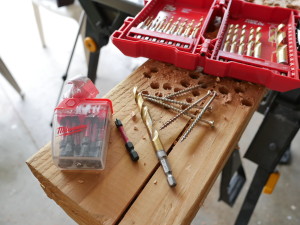 Last year Milwaukee announced and released their new updated line of drilling and driving bits and accessories with the new Shockwave branded drill bits that go by the name “Red Helix” and their new Shockwave impact rated screwdriving bits. I’ve had some time with them and figured I could give you guys my first impressions with these new drilling and screwdriving bits. Before I proceed with the review I want to let you guys know that I’m not a pro and I don’t currently work in the trades. I consider myself “handy” around the house and on occasion embrace projects which require me to pick up a power tool from time to time.
Last year Milwaukee announced and released their new updated line of drilling and driving bits and accessories with the new Shockwave branded drill bits that go by the name “Red Helix” and their new Shockwave impact rated screwdriving bits. I’ve had some time with them and figured I could give you guys my first impressions with these new drilling and screwdriving bits. Before I proceed with the review I want to let you guys know that I’m not a pro and I don’t currently work in the trades. I consider myself “handy” around the house and on occasion embrace projects which require me to pick up a power tool from time to time.
Full disclosure: This a review. I am not paid to give a positive review. These are my opinions. Tool Craze cannot guarantee the accuracy of the information/specifications/features of any tool listed in this article. Manufacturer marketing claims may not always meet expectations. Tool Craze is not responsible if products do not live up to claimed expectations. Please do your full research before buying any products. Tool Craze is an Amazon Associate, and also an affiliate with the Home Depot, Acme Tools, Ohio Power Tool, Tool Nut, Lowe’s, Ebay, and Walmart and places paid links to these retailers. If you purchase something through a link on the Tool Craze site, Tool Craze may get a small share of the sale.
Several years ago when I picked up my first cordless impact driver, the first thing I did was to go get me a set of impact rated screwdriving bits. I went to my local home improvement store and picked out a 5 piece set of #2 Philips Milwaukee Shockwave impact rated screwdriver bits. I believe these were the first generation Shockwave bits and they featured the slimmed down center, which no other manufacturer did at the time. At least as far as I know as all the other manufacturers were making impact rated screwdriving bits that were that same thickness all the way up to the bit tip. This thinner center was designed so that the bits could flex, thus absorbing the high impacting force generated by the high torque of impact drivers. It took the high force from the tip of the bit and transferred it to the center section of the bit and thus would extend the life of the bit tips, at least in theory. It wasn’t soon after that Makita came out with their newly designed Impact Gold bits using the same thin center design that Milwaukee had used, and soon after DeWalt followed suit with their Flex torque and MaxFit impact rated bits, and then just about everyone else joined the thin center impact rated bits wagon.
Going back to those original Milwaukee Shockwave impact rated bits that I had, I wasn’t too crazy about them and this had to do with the poor fitment these #2 bits had. For some reason the Philips head was smaller than other #2 bits at the time and they didn’t fit like regular #2 bits. They were a bit loose and I always had a hard time driving screws because of this. I later ended up finding out that they were much more in line with the size of #1 Philips bits as they fit perfectly on some smaller screws I came across that would use standard #1 Philips bit to drive them. This is why it is important to choose the right size screw! Anyways, they left a bad taste in my mouth and I went back to the store and picked up a competing brands impact rated bits. This time a multi bit set from DeWalt and their #2 Philips bits were the correct size and fit, although they didn’t have the Milwaukee Shockwave thin center to absorb high torque, but they never gave me any problems. I did pick up a new set of Milwaukee Shockwave bits in later on in 2014 and another set in 2015 and Milwaukee did fix the fitment issues associated with the previous #2 Philips bits that I had, as the ones included in these packages had correct fitment for the #2 Philips bits. So it seems they had worked out the kinks with their #2 Philips bits.
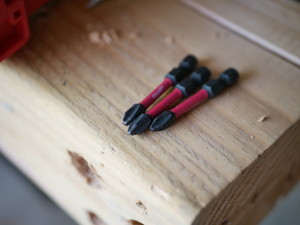 Fast forward to today, now that Milwaukee has updated their Shockwave impact rated screwdriving bits, we can see how they stack up to their previous iteration and we can also compare them to some of the other impact rated bits I’ve been using lately. Compared to the previous version, the new shockwave bits carry over the thin center design and now feature red paint over the slim center versus the plain silver machined finish of the previous bits. The new shockwave bits have almost twice as much length in the thin center compared to the previous bits on 2″ Philips bits. According to Milwaukee these new shockwave bits are rated to last up to 30x longer and absorb 3x more torque than other impact bits. I haven’t had them for that long or haven’t had any projects that required me to destroy any bits so this review will focus more on my first impressions with these bits as I haven’t had enough time to fully test them out for long term durability.
Fast forward to today, now that Milwaukee has updated their Shockwave impact rated screwdriving bits, we can see how they stack up to their previous iteration and we can also compare them to some of the other impact rated bits I’ve been using lately. Compared to the previous version, the new shockwave bits carry over the thin center design and now feature red paint over the slim center versus the plain silver machined finish of the previous bits. The new shockwave bits have almost twice as much length in the thin center compared to the previous bits on 2″ Philips bits. According to Milwaukee these new shockwave bits are rated to last up to 30x longer and absorb 3x more torque than other impact bits. I haven’t had them for that long or haven’t had any projects that required me to destroy any bits so this review will focus more on my first impressions with these bits as I haven’t had enough time to fully test them out for long term durability.
Shockwave Impact Bits
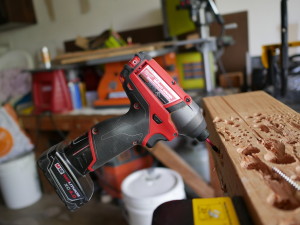 My biggest concern with these new bits was their fitment, seeing as how the competition has been getting this right all along. The biggest test for fitment is with #2 Philips bits as most screws here in the USA use #2 Philips screwdrivers to drive them and a good fitment is crucial for ease of use. Poor fitment can lead to constant damage to the screw heads themselves in the form of repeated screw head stripping, along with premature wear of the drill bits themselves, plus lots of frustration and cursing from the user. So upon fitting a new Milwaukee shockwave #2 bit onto a gold screw, the bit made good contact with the screw with all 4 points on the Philips head and it fit all the way in. Like most #2 Philips bits, there was a small amount of slack, but overall they have good fitment and have good grip for biting into and gripping screws while being driven. I even drove a screw diagonally at a 45 degree angle facing up into some 4×6 lumber and before the screw was driven all the way, I let go of the impact driver to see if the bit had enough grip with the screw that it could hold the impact driver and suspend it in place in such an awkward position without letting go. To my surprise, these new shockwave bits passed the test as they were able to suspend the tool in place without the bit letting go causing the tool to come crashing down into the floor. It held the tool in place long enough so that I could go back into the house to go grab my camera and bring it back to the garage so I could snap a photo which is included in this article.
My biggest concern with these new bits was their fitment, seeing as how the competition has been getting this right all along. The biggest test for fitment is with #2 Philips bits as most screws here in the USA use #2 Philips screwdrivers to drive them and a good fitment is crucial for ease of use. Poor fitment can lead to constant damage to the screw heads themselves in the form of repeated screw head stripping, along with premature wear of the drill bits themselves, plus lots of frustration and cursing from the user. So upon fitting a new Milwaukee shockwave #2 bit onto a gold screw, the bit made good contact with the screw with all 4 points on the Philips head and it fit all the way in. Like most #2 Philips bits, there was a small amount of slack, but overall they have good fitment and have good grip for biting into and gripping screws while being driven. I even drove a screw diagonally at a 45 degree angle facing up into some 4×6 lumber and before the screw was driven all the way, I let go of the impact driver to see if the bit had enough grip with the screw that it could hold the impact driver and suspend it in place in such an awkward position without letting go. To my surprise, these new shockwave bits passed the test as they were able to suspend the tool in place without the bit letting go causing the tool to come crashing down into the floor. It held the tool in place long enough so that I could go back into the house to go grab my camera and bring it back to the garage so I could snap a photo which is included in this article.
So the bit grip is good as it passed the tool grip test, but as good as the grip is, it isn’t the best fitment I’ve tested out. The Makita Impact Gold #2 Philips bits have slightly better overall fitment and in my experience the new Flextorque bits from DeWalt offer better fitment as well. The closest competitor I could compare these new Milwaukee shockwave bits would be the DeWalt impact rated MaxFit bits in the fitment department which offer good #2 Philips fitment as well. Actually I would give the new Milwaukee Shockwave bits the slight advantage over fitment as the Milwaukee bits passed the suspended tool fitment challenge with flying colors, other than that, the fitment is pretty similar.
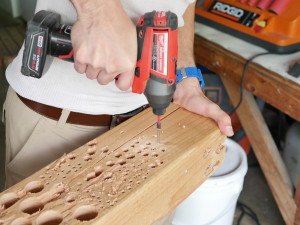 The next thing I noticed with these new Milwaukee bits besides fitment was their durability. Again I haven’t fully exhausted these bits to the point of breakage, but I have noticed that they do wear a slightly bit more than competing impact rated bits. They seem to have great durability under perfect conditions – conditions in which proper pressure is applied to the tool to drive screws and the user is holding the tool at the correct angle straight into the screw to drive them. Under these circumstances these bits will last you a long time and the same is true for most other bits, but in the real world, we don’t always apply the correct pressure or angle or both when driving screws which can lead to bits slipping and stripping screws. Under these circumstances we can see the true durability of your bits and when it comes to theses new Milwaukee bits, they seem to dull out sooner than similar bits. It doesn’t take too many poor driving situations caused by the user to warp and damage the bit tips which also leads to further loss of fitment which leads to more stripping and more slipping. I found that the new feel of these bits didn’t last long with use. It seem like I was reloading bits more often than with other impact rated bits so I could have that new bit feel, fitment, and performance that you get with brand new bits. In contrast both the DeWalt Flextorque and MaxFit bits and Makita Impact Gold bits fared better to bit slipping with Makita taking the lead in my experience. I’m not saying that the new Milwaukee Shockwave bits will deform right away with the slightest misuse by the user as they do hold up well, just not as good as the competition from the bits I’ve tried. You’ll still get plenty of life out of these and even though they will warp a bit more, they will still be plenty usable for a good while before they become unusable. Whether that be breaking or warped to the point that they are not gripping screws very well. With that being said, these bits are still leaps and bounds better than budget bits.
The next thing I noticed with these new Milwaukee bits besides fitment was their durability. Again I haven’t fully exhausted these bits to the point of breakage, but I have noticed that they do wear a slightly bit more than competing impact rated bits. They seem to have great durability under perfect conditions – conditions in which proper pressure is applied to the tool to drive screws and the user is holding the tool at the correct angle straight into the screw to drive them. Under these circumstances these bits will last you a long time and the same is true for most other bits, but in the real world, we don’t always apply the correct pressure or angle or both when driving screws which can lead to bits slipping and stripping screws. Under these circumstances we can see the true durability of your bits and when it comes to theses new Milwaukee bits, they seem to dull out sooner than similar bits. It doesn’t take too many poor driving situations caused by the user to warp and damage the bit tips which also leads to further loss of fitment which leads to more stripping and more slipping. I found that the new feel of these bits didn’t last long with use. It seem like I was reloading bits more often than with other impact rated bits so I could have that new bit feel, fitment, and performance that you get with brand new bits. In contrast both the DeWalt Flextorque and MaxFit bits and Makita Impact Gold bits fared better to bit slipping with Makita taking the lead in my experience. I’m not saying that the new Milwaukee Shockwave bits will deform right away with the slightest misuse by the user as they do hold up well, just not as good as the competition from the bits I’ve tried. You’ll still get plenty of life out of these and even though they will warp a bit more, they will still be plenty usable for a good while before they become unusable. Whether that be breaking or warped to the point that they are not gripping screws very well. With that being said, these bits are still leaps and bounds better than budget bits.
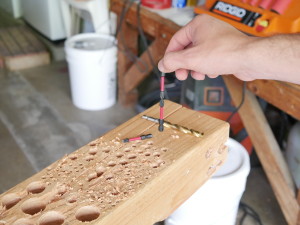 Another interesting thing I found out with these new Milwaukee Shockwave impact rated bits is that they were slightly magnetized. I didn’t see them as marketed as being magnetized so it did come to me as a surprise. It wasn’t a very strong magnetism as they are easily prone to dropping screws. I find it to be a good thing that it wasn’t promoted as it would be rather disappointing if I had the impression that they were magnetized before trying them out as the magnetism isn’t strong. Don’t expect to be able to mount a screw on the bit and expect it to make the trip safely to its final destination as most chances are it will fall out before you get a chance to screw it in. But the upside is that bits are magnetized and may at times hold your screws from falling out so some magnetism is better than none.
Another interesting thing I found out with these new Milwaukee Shockwave impact rated bits is that they were slightly magnetized. I didn’t see them as marketed as being magnetized so it did come to me as a surprise. It wasn’t a very strong magnetism as they are easily prone to dropping screws. I find it to be a good thing that it wasn’t promoted as it would be rather disappointing if I had the impression that they were magnetized before trying them out as the magnetism isn’t strong. Don’t expect to be able to mount a screw on the bit and expect it to make the trip safely to its final destination as most chances are it will fall out before you get a chance to screw it in. But the upside is that bits are magnetized and may at times hold your screws from falling out so some magnetism is better than none.
Shockwave Red Helix Drill Bits
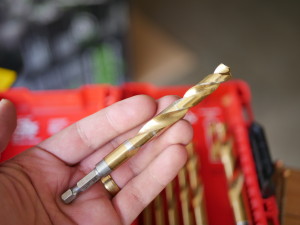 Now lets move onto my experience with the Shockwave Red Helix impact rated drill bits. These drilling bits are also designed for use with the high demands of impact drivers and include 1/4″ hex shanks to fit into impact drivers although they don’t have the thin center “flex” zone in the shank like the screwdriving bits do. Milwaukee incorporated a few interesting features into their Red Helix drill bits which include a “variable helix flute” which is said to remove material faster, a “chip breaker” design which is said to reduce heat build up, and a 135° split point to prevent walking. The variable helix flute is said to feature a 35 degree helix angle that varies along the flute and ends at 15 degrees. If that doesn’t make any sense to you, like me, you probably isn’t the only one. It all makes for great sales tactics on the box description but keep reading to see my thoughts on how they actually perform. Milwaukee introduced 2 Red Helix lines of drill bits, one under the Shockwave name which offers a titanium coating and have 1/4″ hex shanks for use with impact drivers (as we all know impact drivers can’t use regular drill bits with round shanks) and the Cobalt Red Helix line of drill bits which are cobalt steel drill bits. They feature the same features of the shockwave bits, minus the 1/4″ hex shank and offer superior durability at a stated up to 10x longer life than black oxide bits, while the shockwave red helix bits are rated for up to 3x longer life than black oxide bits.
Now lets move onto my experience with the Shockwave Red Helix impact rated drill bits. These drilling bits are also designed for use with the high demands of impact drivers and include 1/4″ hex shanks to fit into impact drivers although they don’t have the thin center “flex” zone in the shank like the screwdriving bits do. Milwaukee incorporated a few interesting features into their Red Helix drill bits which include a “variable helix flute” which is said to remove material faster, a “chip breaker” design which is said to reduce heat build up, and a 135° split point to prevent walking. The variable helix flute is said to feature a 35 degree helix angle that varies along the flute and ends at 15 degrees. If that doesn’t make any sense to you, like me, you probably isn’t the only one. It all makes for great sales tactics on the box description but keep reading to see my thoughts on how they actually perform. Milwaukee introduced 2 Red Helix lines of drill bits, one under the Shockwave name which offers a titanium coating and have 1/4″ hex shanks for use with impact drivers (as we all know impact drivers can’t use regular drill bits with round shanks) and the Cobalt Red Helix line of drill bits which are cobalt steel drill bits. They feature the same features of the shockwave bits, minus the 1/4″ hex shank and offer superior durability at a stated up to 10x longer life than black oxide bits, while the shockwave red helix bits are rated for up to 3x longer life than black oxide bits.
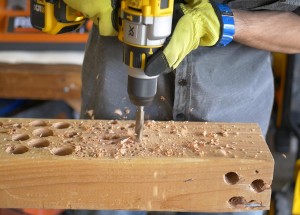 I drilled holes into lumber and metal using several 12V and 18V drills and impact drivers while comparing the Milwaukee Red Helix bit to similar DeWalt bits I had on hand. My first use with them was drilling into some dimensional lumber (4×6). I used various sizes ranging from 3/16″ up to 1/2″. Side by side with my DeWalt bits, in terms of drilling speed, they were very close. With small bits around 3/16″ size, there was no noticeable difference in wood drilling speed but there is a slight difference in speed as the sizes go up. Particularly with the largest sizes such as 3/8″ and 1/2″ I noticed that the Milwaukee bits were a bit more aggressive which lead to slightly faster drilling speeds. It wasn’t much but it was there. As far as bit walking goes, even though the Milwaukee bits are said to be designed with tips that prevent walking, all bits fared about the same and showed considerable bit walking before the bits would bite into the wood and drill through. This was particularly more noticeable with larger bits and less noticeable with smaller bits.
I drilled holes into lumber and metal using several 12V and 18V drills and impact drivers while comparing the Milwaukee Red Helix bit to similar DeWalt bits I had on hand. My first use with them was drilling into some dimensional lumber (4×6). I used various sizes ranging from 3/16″ up to 1/2″. Side by side with my DeWalt bits, in terms of drilling speed, they were very close. With small bits around 3/16″ size, there was no noticeable difference in wood drilling speed but there is a slight difference in speed as the sizes go up. Particularly with the largest sizes such as 3/8″ and 1/2″ I noticed that the Milwaukee bits were a bit more aggressive which lead to slightly faster drilling speeds. It wasn’t much but it was there. As far as bit walking goes, even though the Milwaukee bits are said to be designed with tips that prevent walking, all bits fared about the same and showed considerable bit walking before the bits would bite into the wood and drill through. This was particularly more noticeable with larger bits and less noticeable with smaller bits.
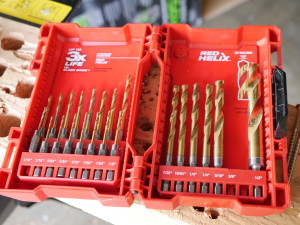 A few things I did notice that stood out with the Milwaukee Red Helix bits were that they were slightly more aggressive with the larger sizes and this really helps out when using cordless tools that don’t have the kind of power of corded tools such as the 12V tools. This gives weaker power tools a bit of a speed and power boost thanks to these Milwaukee bits. The red helix flutes did well with spitting out chips as they drilled into wood and seemed to do this slightly better than the competition although they were also susceptible to clogging at times if you didn’t move the bits in and out to give them a chance to clear the wood. There was one negative I found with the Shockwave Red Helix bits that I didn’t like much, which was the fact that the shockwave drill bits were much shorter than the competition, even directly against other impact rated drill bits with 1/4″ hex shanks. Milwaukee’s shockwave red helix bits were too short in my opinion and at times when working on projects, I had to use other same sized but longer bits to finish my holes. This is especially true with the smaller shockwave red helix bits. Just to give you an idea of how short the Milwaukee shockwave red helix bits are, their 1/16″ bits have only 1″ of usable length. Their 1/8″ bits have only 1-5/16″ of usable length and their 3/16″ bits have 1-3/4″ usable lengths. Although sizes from 13/64″ and up have considerably longer lengths in comparison, so this is more of an issue with their smaller bits. Short bit length was not an issue with the Red Helix Cobalt bits as these were all normal lengths according to their size.
A few things I did notice that stood out with the Milwaukee Red Helix bits were that they were slightly more aggressive with the larger sizes and this really helps out when using cordless tools that don’t have the kind of power of corded tools such as the 12V tools. This gives weaker power tools a bit of a speed and power boost thanks to these Milwaukee bits. The red helix flutes did well with spitting out chips as they drilled into wood and seemed to do this slightly better than the competition although they were also susceptible to clogging at times if you didn’t move the bits in and out to give them a chance to clear the wood. There was one negative I found with the Shockwave Red Helix bits that I didn’t like much, which was the fact that the shockwave drill bits were much shorter than the competition, even directly against other impact rated drill bits with 1/4″ hex shanks. Milwaukee’s shockwave red helix bits were too short in my opinion and at times when working on projects, I had to use other same sized but longer bits to finish my holes. This is especially true with the smaller shockwave red helix bits. Just to give you an idea of how short the Milwaukee shockwave red helix bits are, their 1/16″ bits have only 1″ of usable length. Their 1/8″ bits have only 1-5/16″ of usable length and their 3/16″ bits have 1-3/4″ usable lengths. Although sizes from 13/64″ and up have considerably longer lengths in comparison, so this is more of an issue with their smaller bits. Short bit length was not an issue with the Red Helix Cobalt bits as these were all normal lengths according to their size.
I also tested these bits out with metal to see their metal drilling performance. I drilled into some very thin gauge steel and a some thick square tubing. Drilling performance did well across the board for both the Milwaukee Shockwave and Cobalt Red Helix bits. Unlike with wood drilling, I did not see any bit walking with these Milwaukee bits so they passed with flying colors. They were so good at not walking that they even held up very well when starting holes at a slight angle – of course if the angle was too sharp then it would still walk but that would be due to user error and not the bits fault. In comparison the DeWalt bits held up well as well with little to no walking.
Metal drilling speed was very good and consistent as I drilled 3 consecutive holes with each Milwaukee bit used. In comparison the DeWalt bits did well in this regard with slight slowing at the start on the third hole, although one competing brands black oxide bit that I had on hand had huge slow down by the second consecutive hole and was unable to finish the the third hole as the bit heated up and dulled to the point of failure. As far as long term durability goes, I didn’t test any of them for that so all of the above results are based on initial testing.
DISCLOSURE:
Tool Craze does not sell this product or any product on the Tool Craze website. Tool Craze does not handle the sale of any item in any way. Tool Craze is an OhioPowerTool affiliate and an Amazon Associate and places paid links including those from other retailers Tool Craze is an affiliate partner with. If you purchase something through a link on the Tool Craze site, Tool Craze may get a small share of the sale. Please refer to the About section for more info. Tool Craze cannot guarantee the accuracy of the information/specifications/features of any tool listed in this article. Please do your full research before buying any products.


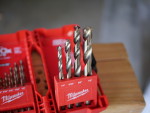
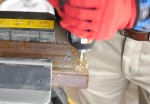
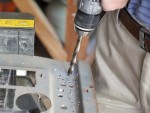
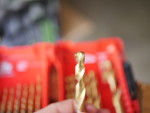
Leave a Comment